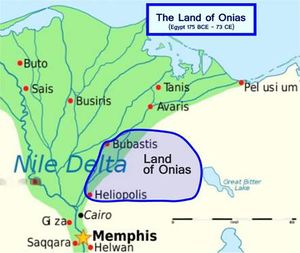Category:Heliopolis (subject)
The Heliopolis Temple was a Jewish temple built in the early 2nd century BCE Egypt by members of the House of Zadok after they lost power in Jerusalem. The temple functioned until 73 or 74 CE, when it was destroyed by the Romans, following the destruction of the Jerusalem temple in 70 CE.
Overview
After the leaders of the House of Zadok lost their power in Jerusalem, they fled to Egypt, with a large following, where they were welcomed by the Ptolomies. King Ptolemy IV Philometor allowed Onias IV to build a military colony and a new Temple at Heliopolis. The legitimacy of the Temple was based on a prophecy of Isaiah:
- "[18] On that day five cities in the land of Egypt will be speaking the language of Canaan and swearing allegiance to the LORD of hosts; one will be called the City of the Sun [i.e. Heliopolis]. [19] On that day there shall be an altar to the LORD in the midst of the land of Egypt, and a pillar to the LORD near its border" (Isaiah 19:18-19).
While 1QIsa preserves the original text of the passage ('ir ha-heres, "City of the Sun"), the different versions in the Septuagint (Asedek, 'ir ha-sedek, "City of Righteousness") and in the MT ('ir ha-heres, "City of Evil") betray the opposite views about the legitimacy of the Temple.
The new Jewish settlers were loyal to the Ptolemaic monarchy throughout the 2nd century BCE and the region of Heliopolis came soon to be known as the "Land of Onias (Josephus, Ant 13, 287). Onias IV (and his sons Ananias and Chelkias) became important military figures in the Ptolemaic court and were deeply involved in the political intrigues and warfare of their time. In 103 BCE Chelkias died in battle, when Cleopatra III was campaigning in Palestine and Syria. The Oniads lost their last chance to regain power in Jerusalem.
With the Roman conquest, the Heliopolis Temple lost its importance and remained a marginal presence in Judaism until it was destroyed by the Romans in 73 or 74 CE (Josephus, War 7, 420-436). Nothing is recorded about the last High Priests serving in the Temple, whether they were direct descendants of Onias IV or not. Later Jewish traditions would preserve only confused memories of the Jewish temple "in the City of Heliopolis, which will be destroyed" (Tg Ps-J Isa 19:18; cf. m. Menah 13:10; b. Menahot 109b-110a).
The exact location of the Temple remains unknown. Josephus says that it was built in a place called Leontopolis but such a name is not otherwise attested. The ruins of the Temple have not been found or identified by modern archaeologists.
Heliopolis in ancient sources
References
- Heliopolis / R. Hayward / T&T Clark Encyclopedia of Second Temple Judaism (2019 Stuckenbruck, Gurtner), dictionary
- Heliopolis / Gideon Bohak / The Eerdmans Dictionary of Early Judaism (2010 Collins / Harlow), dictionary, 721-723
Pages in category "Heliopolis (subject)"
The following 3 pages are in this category, out of 3 total.
